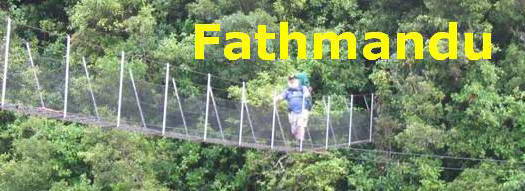
Many thanks for permission to use graphics from their software and toposheets |
 |
|
One Step at a Time:
A jorney of10,000 steps begins by killing a hell of a lot of pine trees. This is the track I should have been training on — and training on and training on — for Day 1 of the St James Walkway. Plenty of up and down, nothing too drastic, and zillions of steps that require you to lift your foot higher than usual and then step off on it. Fat people listen up. Power to weight ratio. Put very crudely, and leaving out the Jonah Lomu factor, our weight is a function of our total mass, while our ability to move that weight around is a function of the cross sectional area of our muscles. Our weight increases much faster than our ability to move it around. If our weight doubles, our ability to move it around increases by a factor of around 1.6 max. It is therefore vitally important for us fat ones to train our walking and stabiliser muscles, just to stay level with skinny persons who decide to do a five day walk about a week or two ahead without very much training. It is also useful to lose as much weight as possible while training. Every little bit helps. So, this is a good training walk once you have established a basic level of fitness by walking your 3 - 6 km a night for a while around the local streets and weekend rambling in the Woodhill forest.
It's a popular walk. On a weekend like this expect to meet upwards of 60 people in small groups on the track. Park your car as near as possible to the end of the public section of Haigh's Access Rd off East Coast Bays Rd. (WARNING. The area has at times been subject to vandalism and car-break-ins, but mostly when there are relatively few people around.) The full walk takes you right through to Stillwater. This one is about 3 hr return, fatman time, including a 20 min break for lunch where the track joins the beach.
Don't be fooled by the relatively smooth appearance of the red line marking the track. It disguises a fair amount of zigzagging and up and downing.
There's a useful information board just to the left of this. We head off along the estuary, on a broad track.
Some of the mangroves are in flower.
(The track quality along here is for the most part excellent) We've only been walking 50m and already the first group has overtaken us.
The vegetation here consists for the most part of the usual suspects: kanuka, hangehange, mapau, karamu, rangiora and assorted ferns and grasses. It's April and just beginning the fungi season in our forests. The pine forests up our way, besides their notorious harvest of psilocybin mushrooms, are for the next three months a multi-coloured display of fungi, well worth tracking with a camera. Do not harvest the psilocybin mushrooms unless you can run faster than an alsatian police dog.
As we cross the bridge over the Okura River, it changes dramatically.
A kowhai sits just to the right of the bridge. The east coast estuaries from here to Warkworth are lined with these and quite spectacularly beautiful in flower in the spring. Along the edge of the estuary are a number of big kahikatea. Kahikatea are some of the tallest trees in New Zealand, many of them more than 60m tall.)
The tide is about half out as we cross the bridge
Years ago, before the reserve was gazetted, we used to bring the kids here to fish for sprats off the bridge at the full tide. These days it's all protected. Sometimes it concerns me that we're turning the country into a museum to show people how lucky we used to be. Over the bridge and the first thing we encounter is a grove of nikau.
We pass these and begin a series of long zigzags up the side of the ridge. Somewhere around here Miranda begins to chafe. Even the most saintly of midwives visited with several long slow labours in the course of the same week begins to crave action. She has finally made it out of doors and she wants to get moving. Is it OK if she takes off at speed? Certainly, it is. She is carrying the lunch so I won't be too far behind.
We're now walking through a patch of taraire and puriri and their thick leathery leaves carpet the track. Some of the trees are host to a spectacular orange lichen. The older puriri are scarred with puriri moth holes,
The track continues to climb, well-behaved and gentle for the most part, but soon enough we strike the first steps.
Now there are times when you appreciate steps, and you pronounce a short blessing on the DOC workers who have put in so much time and effort, but what I have noticed is that given half a chance and some room beside the steps, most trampers will beat a path to the side. I notice that with a pair of hiking poles today is a lot easier than some occasions in the past when my legs have ached from too many steps and my knees have stayed hot for hours from the successive impacts of step after step, up or down. Without steps, even on steeper slopes I tend to adjust stride length and lift to suit terrain and load. Typically steps impose a regime that suits neither. |
|